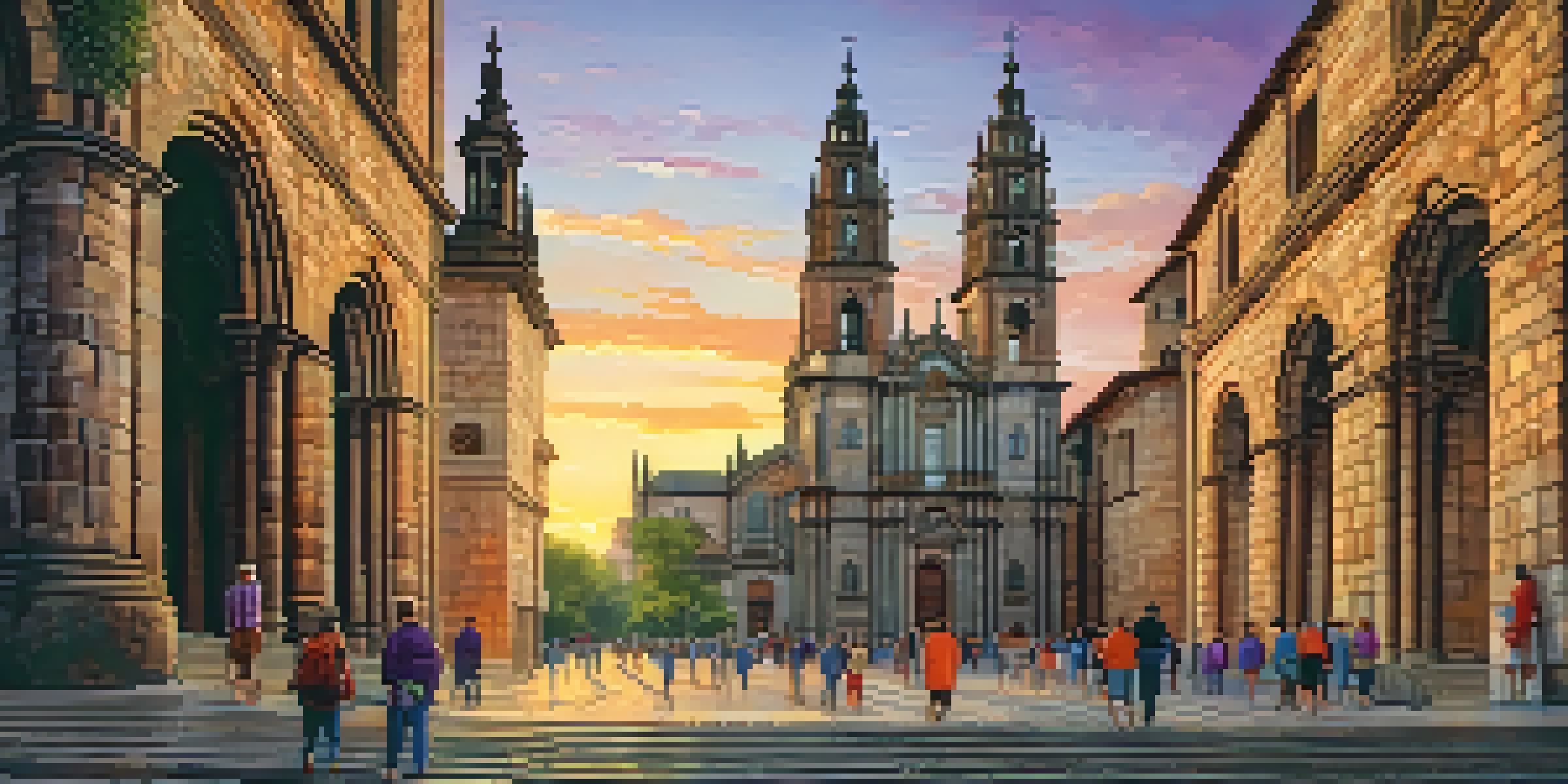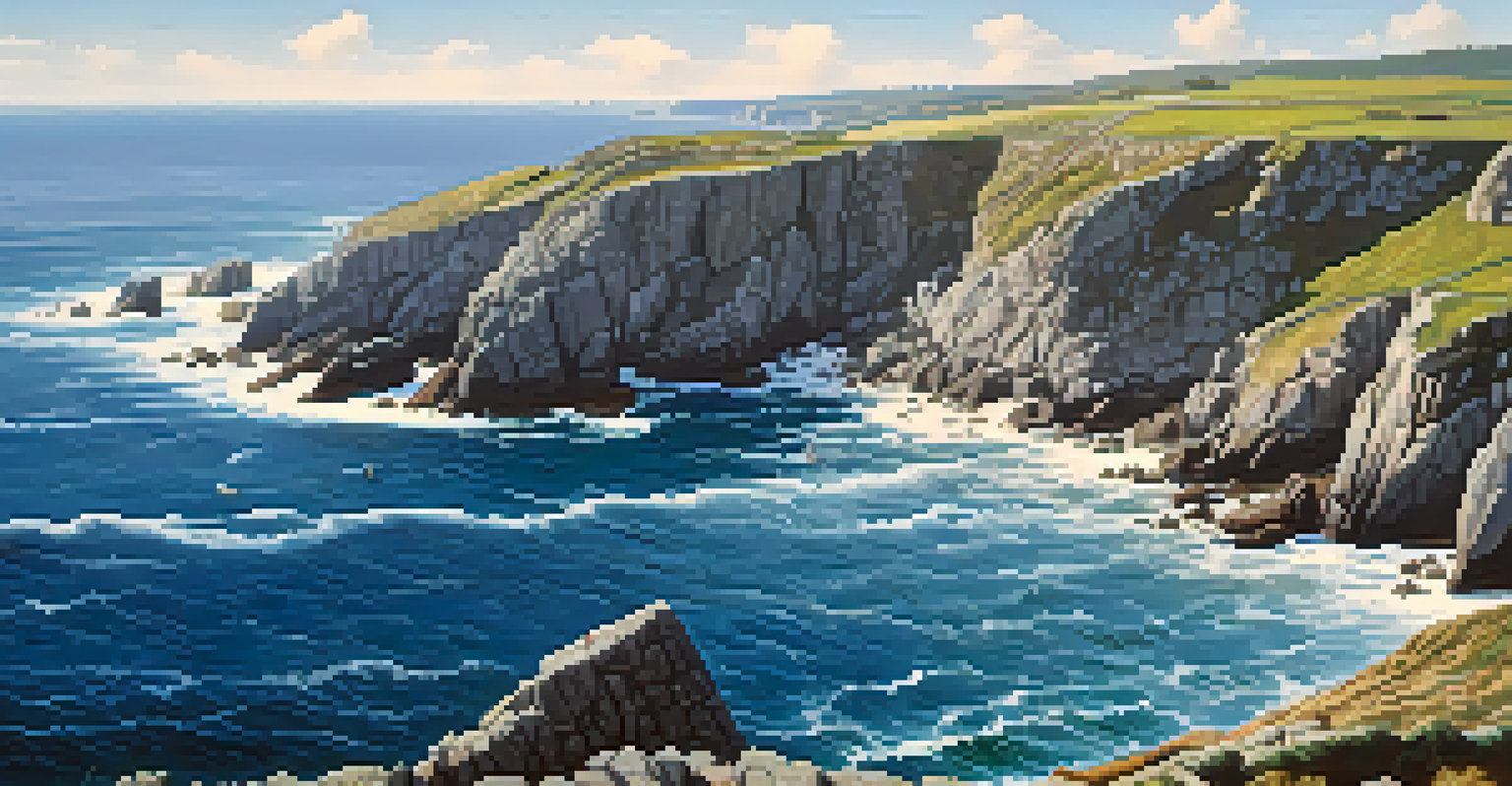Santiago de Compostela: A Pilgrim's Path to Cinematic Sites

The History of Santiago de Compostela and Its Pilgrimage
Santiago de Compostela, nestled in the northwest of Spain, is renowned for its rich history and spiritual significance. It has been a pilgrimage destination since the 9th century, believed to be the burial site of Saint James, one of Jesus' apostles. Pilgrims from around the world journey here, drawn by both faith and the allure of adventure. This historic path is not just a journey of the spirit; it's also a path that has inspired countless filmmakers and storytellers.
The journey of a thousand miles begins with one step.
Walking the Camino de Santiago is an experience steeped in awe as pilgrims traverse stunning landscapes and enter charming villages. The trails, often surrounded by lush greenery and ancient architecture, evoke a sense of timelessness. This rich backdrop has not only attracted travelers but also filmmakers looking to capture the essence of pilgrimage. By exploring these paths, one can appreciate both the historical and cinematic allure of this remarkable place.
From the vibrant city of Santiago to the peaceful countryside, the pilgrimage offers a unique blend of spirituality and cinematic beauty. The journey itself becomes a story, filled with challenges, reflections, and moments of connection. It’s no wonder that many films have turned their gaze toward this iconic route, celebrating its ability to transform individuals and inspire narratives.
Iconic Films Set in Santiago de Compostela
Santiago de Compostela has served as a backdrop for numerous films, each capturing its enchanting atmosphere. One notable example is 'The Way,' starring Martin Sheen, which follows a father's journey along the Camino after the tragic death of his son. This film beautifully illustrates the transformative power of the pilgrimage, highlighting how the journey can lead to self-discovery and healing. The stunning visuals of Santiago and its surrounding landscapes add depth to the narrative.

Another film, 'The Way of St. James,' delves deeper into the historical and spiritual significance of the Camino. It showcases the rich culture and traditions found along the route, inviting viewers to experience the journey as if they were walking it themselves. The film not only captivates with its storytelling but also encourages audiences to reflect on their own life paths and the importance of perseverance.
Santiago: A Pilgrimage Destination
Santiago de Compostela has been a revered pilgrimage site since the 9th century, attracting travelers seeking spiritual growth and adventure.
These films not only entertain but also inspire viewers to explore Santiago de Compostela for themselves. The cinematic portrayal of the pilgrimage encourages a sense of adventure and curiosity, making the path feel both accessible and mystical. As audiences engage with these stories, they may find themselves yearning to embark on their own journey, walking the same paths that brought others to profound realizations.
The Cultural Significance of Pilgrimage in Cinema
Pilgrimage, as depicted in cinema, often symbolizes a journey of personal growth and discovery. This theme resonates deeply in films set along the Camino de Santiago, where characters undergo significant transformations. The act of walking becomes a metaphor for facing life's challenges and finding one's true self. By exploring the cultural significance of pilgrimage, filmmakers tap into a universal experience that many can relate to.
Not all those who wander are lost.
The intersection of spirituality and cinema creates a powerful narrative tool. Filmmakers often use the pilgrimage as a way to illustrate broader themes such as faith, healing, and redemption. These elements create an emotional connection with the audience, allowing them to reflect on their own life journeys. The cultural significance of pilgrimage extends beyond the screen, inviting viewers to contemplate the deeper meanings behind their own paths.
By showcasing the rich tapestry of experiences along the Camino, these films help preserve the cultural heritage of Santiago de Compostela. They remind us that pilgrimage is not just a physical journey but also a profound exploration of human connection and purpose. This cultural narrative elevates the cinematic experience, making it resonate with viewers long after the credits roll.
Exploring Cinematic Locations in Santiago
As you walk the Camino de Santiago, you’ll encounter various locations that have appeared in films. The majestic Cathedral of Santiago de Compostela is a must-visit, serving as both a spiritual destination for pilgrims and a stunning cinematic backdrop. Its intricate architecture and rich history evoke a sense of wonder, making it a popular spot for filmmakers looking to capture the essence of pilgrimage. Visitors might even find themselves reenacting memorable scenes from their favorite films.
Another iconic location is the picturesque town of Finisterre, known as the 'end of the world.' Its breathtaking cliffs and ocean views have been featured in several films, symbolizing the culmination of the pilgrimage journey. Standing on the edge of the land, you can experience the same sense of awe that filmmakers aim to capture. The unique beauty of this setting creates an unforgettable atmosphere that resonates with both pilgrims and movie enthusiasts alike.
Cinematic Influence on Tourism
Films like 'The Way' have significantly boosted interest in pilgrimage tourism, encouraging more visitors to walk the Camino de Santiago.
Exploring these cinematic sites allows visitors to connect with the stories told through film while experiencing the magic of Santiago firsthand. Whether standing in front of the grand cathedral or gazing out at the ocean from Finisterre, each location invites reflection and inspiration. The journey becomes a blend of reality and storytelling, where the lines between the two blur, enriching the pilgrimage experience.
The Impact of Cinema on Pilgrimage Tourism
The influence of cinema on pilgrimage tourism in Santiago de Compostela cannot be overstated. Films like 'The Way' have sparked interest in the Camino, leading to a surge in visitors eager to walk the path themselves. As people watch these stories unfold on screen, they feel compelled to experience the journey, resulting in increased foot traffic along the pilgrimage routes. This phenomenon showcases how powerful storytelling can inspire real-life adventures.
Tourism boards and local businesses have recognized this impact, often collaborating with filmmakers to promote the Camino. By highlighting cinematic locations and experiences, they attract both pilgrims and film enthusiasts alike. This symbiotic relationship benefits the local economy, as more visitors flock to enjoy the beauty and culture of Santiago. The intertwining of cinema and tourism creates a vibrant atmosphere that celebrates both the art of storytelling and the spirit of pilgrimage.
Additionally, as more people walk the Camino, they share their experiences through social media and other platforms, further amplifying the reach of these cinematic narratives. This modern-day storytelling continues to inspire future generations of pilgrims. As the world becomes increasingly interconnected, the cinematic portrayal of Santiago de Compostela serves as a bridge, connecting individuals through shared experiences and inspiring them to embark on their own journeys.
Preparing for Your Cinematic Pilgrimage
If you're inspired to embark on your own cinematic pilgrimage to Santiago de Compostela, preparation is key. Start by researching the various routes available, as each offers unique experiences and landscapes. Whether you choose the popular French Way or the scenic Portuguese Way, understanding the terrain and what to expect will enhance your journey. Planning your itinerary with an eye on the significant cinematic sites can also enrich your experience.
Packing wisely is essential for a successful pilgrimage. Comfortable walking shoes, weather-appropriate clothing, and a good camera for capturing your journey are must-haves. Don't forget a journal to document your thoughts and reflections along the way. As you traverse the paths that have inspired filmmakers, you'll likely find moments worth noting, whether it's a stunning view or a profound realization.
Reflections and Transformations
The journey along the Camino not only offers breathtaking landscapes but also fosters personal growth and reflection, mirroring the transformative narratives found in cinema.
Finally, embrace the spirit of the journey. While it's easy to get caught up in reaching Santiago, remember that the pilgrimage is about the experiences and connections made along the way. Interacting with fellow pilgrims and locals will enhance your understanding of the cultural significance of the Camino. By immersing yourself in both the journey and its cinematic history, you'll create lasting memories that resonate beyond the screen.
Reflections on the Journey: Santiago and Beyond
As you complete your pilgrimage in Santiago de Compostela, take a moment to reflect on your journey. The experience goes beyond just reaching a destination; it's about the lessons learned and the connections made along the way. From the breathtaking landscapes to the stories of fellow pilgrims, each moment contributes to a richer understanding of life and purpose. These reflections often mirror the narratives portrayed in films, emphasizing the transformative power of the journey.
Many who walk the Camino find that the experience changes their perspective on life. Just as characters in films undergo significant transformations, pilgrims often return home with renewed clarity and purpose. This shared sense of growth connects the cinematic experience to real-life journeys, illustrating how storytelling can inspire change. The impact of your pilgrimage may echo long after you’ve left Santiago, influencing your daily life and decisions.

Ultimately, the journey to Santiago de Compostela serves as a reminder that every path we take, whether in life or in film, holds potential for discovery and transformation. As you step away from the trails, carry the essence of your experience with you. Allow it to inform your view of the world and inspire your future adventures, both on and off the screen.